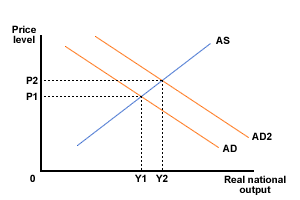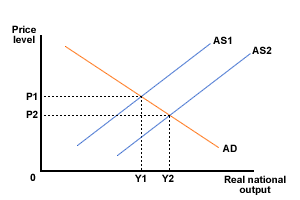Summary of AD and AS
Syllabus: Examine, using diagrams, the impacts of changes in shortrun equilibrium.Both aggregate demand and supply curves are aggregates - that is,
they are the total of either all demand or all supply within the
economy.
Aggregate demand slopes downwards (see Page 44) and
shows that as the average price level in the economy falls the
aggregate demand for real output increases.
A change in any of its components (C+I+G+X-M) will SHIFT the AD curve to a new position. So, if a country becomes more successful in exporting its products to other countries, the AD line will shift to the right as in the diagram below (Figure 2). A similar situation will arise if the government stimulated the economy via expansionary fiscal or monetary policy.

Figure 2 Increased aggregate demand
The aggregate supply curve shows the total output of goods and services, which the firms or producers or suppliers plan to supply, at a given price level. A change in any of the determinants of AS (Q and Q of FoP), apart from the price level (Mover), will shift the AS curve to a new position.
If, or when, any of these change the curve can shift. In the diagram below (Figure 3), import prices have fallen and so too have the costs of production - the AS curve has therefore moved to the right (outwards).

Figure 3 Increased aggregate supply
Have a go at shifting the AD/AS curves for each of the changes below, practice drawing the diagrams, original equilibrium AD and AS curves and show how the equilibrium has changed. Once you have answers to the outlined changes, follow the links to see if your answers agree (check your learning).
Illustrate the effect on equilibrium of the following:
- The central bank is concerned about future inflation and so increases interest rates.
- The exchange rate depreciates, leading to a fall in export prices and an increase in import prices.
- Consumers are concerned about high levels of debt and so reduce spending and increase saving to try to reduce their indebtedness.